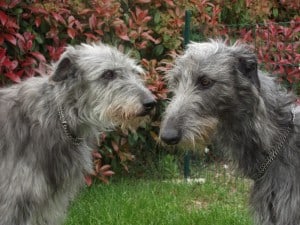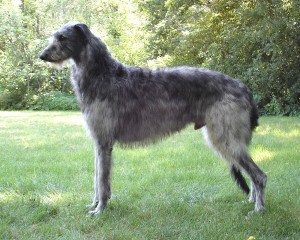
Easy to train and very gentle, the Scottish Deerhound is a great pet. They are cautious, but not aggressive around strangers and enjoy the company of children, provided they are socialized with them from a young age. Although the Scottish Deerhound can be socialized to enjoy the company of other animals, they do tend to chase them, especially cats. They run very fast so it is best to keep them on a leash except in secure areas. The Scottish Deerhound needs lots of exercise, and so is best suited for suburban or rural areas with lots of room to run. They make great company on jogs.
The Scottish Deerhound resembles a Greyhound in appearance, although they are somewhat larger and have a shaggier coat. The breed averages between 28 and 32 inches in height and between 75 and 110 pounds. They have a shaggy coat, usually around three or four inches long. The coat is quite coarse and usually a shade of gray, although brindle, red, and yellow are common as well. Scottish Deerhounds may have white markings on the feet, tail, and chest. They have a lean, elegant stature and carry their head high. The Scottish Deerhound’s tail is very long and reaches nearly to the ground.

Scottish Deerhounds should be brushed weekly. They need lots of exercise and so should be walked several times daily and allowed to play freely weekly.Scottish Deerhounds are susceptible to bloat and therefore should be fed a couple of small meals daily rather than one large one. It is wise to avoid exercise directly after eating. Common health problems associated with the breed are bloat and osteochondritis dissecans.
